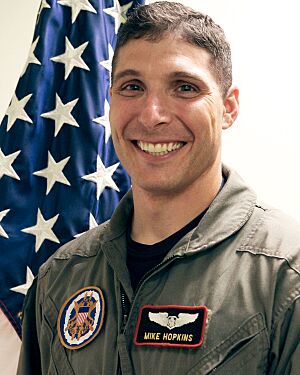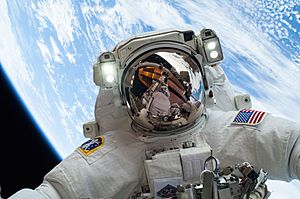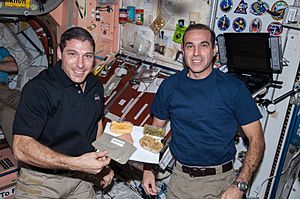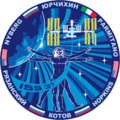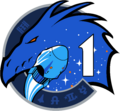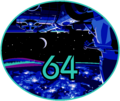Michael S. Hopkins facts for kids
Quick facts for kids
Mike Hopkins
|
|
|---|---|
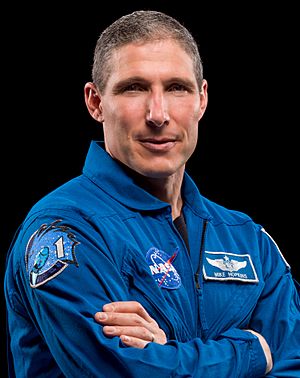
Official portrait, 2020
|
|
| Born |
Michael Scott Hopkins
December 28, 1968 Lebanon, Missouri, U.S.
|
| Space career | |
| NASA astronaut | |
| Rank | Colonel, USSF |
|
Time in space
|
333d 12h 54m |
| Selection | NASA Group 20 (2009) |
|
Total EVAs
|
5 |
|
Total EVA time
|
32h 1m |
| Missions | Soyuz TMA-10M (Expedition 37/38) SpaceX Crew-1 (Expedition 64/65) |
|
Mission insignia
|
 |
Michael Scott "Mike" Hopkins (born December 28, 1968) is a retired NASA astronaut and a United States Space Force colonel. He was chosen by NASA to become an astronaut in June 2009. Mike Hopkins made his first trip to space as a flight engineer on the Soyuz TMA-10M spacecraft. This mission was part of Expedition 37 and Expedition 38 to the International Space Station. He lived and worked in space from September 2013 to March 2014. He was the first astronaut from his group to fly into space. Mike Hopkins also made history as the first astronaut to join the U.S. Space Force. He even had a special ceremony for this while he was on the International Space Station. Before joining the Space Force, he served in the United States Air Force for more than 27 years.
Contents
Mike Hopkins: Early Life and Education
Michael Scott Hopkins was born on December 28, 1968. He was born in Lebanon, Missouri, but grew up on a farm in Richland, Missouri. His family was part of the United Methodist church.
After finishing high school in 1987, he went to the University of Illinois at Urbana-Champaign. While there, he played football as a defensive back for the Illinois Fighting Illini football team. He was also honored with the Big Ten Medal of Honor. This award recognizes students who are excellent in both sports and academics.
In 1991, he earned a Bachelor of Science degree in aerospace engineering. He then continued his studies at Stanford University. In 1992, he received a Master of Science degree, also in aerospace engineering.
Mike Hopkins' Military Career
Mike Hopkins joined the United States Air Force after college. He became a second lieutenant in January 1992. Early in his Air Force career, he worked on advanced space systems at Kirtland Air Force Base in Albuquerque, New Mexico.
In 1996, he attended the U.S. Air Force Test Pilot School. He became a top flight test engineer there. After that, he tested large cargo planes like the C-17 and C-130. In 1999, he worked with the Canadian Flight Test Center in Cold Lake, Alberta.
Later, he studied political science in Parma, Italy, as an Olmsted Scholar. In 2005, he worked at the Pentagon as a project engineer. Before becoming an astronaut, he was a special assistant to General James Cartwright.
Mike Hopkins' NASA Career
In 2009, NASA chose Mike Hopkins as one of nine new astronauts. He started his training at the Johnson Space Center that year. His training lasted two years and included many things. He learned about the International Space Station systems and how to do spacewalks. He also trained in robotics, flying T-38 jets, and survival skills. He finished his training in November 2011.
After his training, Hopkins was ready for a space mission.
First Space Mission: Expedition 37/38
In February 2011, Mike Hopkins was assigned to his first space mission. He was the first astronaut from his group to get a flight assignment. He trained with Russian cosmonauts Oleg Kotov and Sergey Ryazansky for a long stay on the Space Station.
On September 25, 2013, Hopkins and his crewmates launched aboard the Soyuz TMA-10M spacecraft. They docked with the International Space Station a few hours later. They joined the Expedition 37 crew already there.
During his time on the station, Hopkins became part of the Expedition 38 crew. He took part in two spacewalks with fellow astronaut Rick Mastracchio. These spacewalks lasted over 13 hours in total. During these spacewalks, they worked on the outside of the station. They performed maintenance and made upgrades.
Hopkins and his two crewmates left the station on March 10, 2014. They landed in Kazakhstan less than five hours later. This first spaceflight lasted 166 days.
Second Space Mission: Expedition 64/65
In August 2018, Mike Hopkins was chosen for another mission. He was assigned to fly on SpaceX Crew-1, the first regular mission of the SpaceX Crew Dragon spacecraft. He flew with Victor Glover, Shannon Walker, and Soichi Noguchi.
On November 15, 2020, they launched on the Crew Dragon Resilience. They arrived at the International Space Station two days later.
On December 18, 2020, Mike Hopkins made history again. He became the first astronaut to transfer from the Air Force to the Space Force. This special ceremony happened while he was on the International Space Station.
On January 27, 2021, Hopkins performed his third spacewalk with Victor Glover. They worked for almost seven hours to upgrade the Columbus module. This was Glover's first spacewalk.
On February 1, 2021, Hopkins did his fourth spacewalk, also with Glover. They replaced a broken camera and upgraded two others. They also finished a four-year project to replace the station's batteries.
The Crew-1 mission splashed down in the Gulf of Mexico on May 2, 2021. This mission lasted 167 days in space.
Retirement from NASA
In June 2023, NASA announced that Mike Hopkins had retired from his role as an astronaut. In September 2024, he appeared as a commentator for SpaceX's live coverage of the Polaris Dawn spacewalk.
Mike Hopkins' Personal Life
Mike Hopkins is married to Julie Hopkins. They have two sons. In 2013, Mike Hopkins joined the Catholic Church, like his wife and children. For his first mission to the ISS, his pastor helped him bring the Eucharist so he could have Communion once a week.
Images for kids
See also
 In Spanish: Michael S. Hopkins para niños
In Spanish: Michael S. Hopkins para niños


